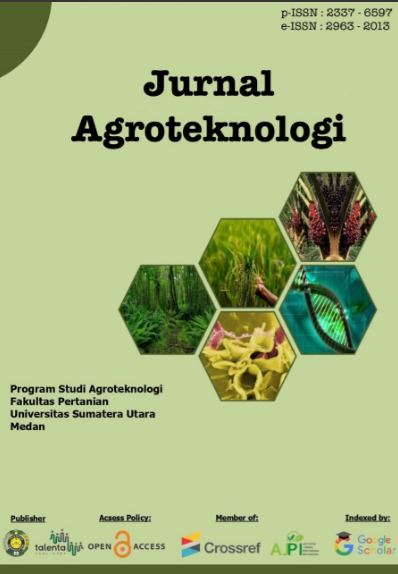The Effect of Age of Planting and Three Types of Organic Fertilizers on the Growth and Production of Mustard Greens (Brassica juncea L.)
DOI:
https://doi.org/10.32734/ja.v11i3.12759Keywords:
Mustrad greens, Age of transplanting, Organic fertilizerAbstract
The age of transplanting is quite important in the cultivation of mustard greens.
This research aims to know the best transplanting, which was carried out on
farmer's land in Tanjung Sari Village, Medan Selayang District, Medan, North
Sumatra with an altitude of about 25 meters above sea level (masl) starting from
February to April 2023. This study used a factorial randomized block design
(RBD) which consisted of 2 factors: factor 1 was the age of transplanting (U) which
consisted of 3, namely: U1 = 10, U2 = 15, U3=20 DAS (Day After Sowing). Factor
2 wasthe addition of the type of organic fertilizer (O), which consisted of 4, namely:
O0=Soil, O1=Soil+Kacing Fertilizer (25 tons/ha or 62.5 grams/polybag), O2=Soil
+ Chicken Manure (25 tons/ ha or 62.5 gram/polybag), O3=Soil+Cow Manure (25
ton/ha or 62.5 gram/polybag). The results showed that the best transplanting age
was 20 DAS which was significantly different from the other treatments on the
parameters of plant length, number of leaves, diameter of pseudo stems, and weight
of biomass per sample. The best organic fertilizer in this study was chicken manure
which was not significantly different from vermicompost fertilizer and had a
significant effect on the parameters of plant length, number of leaves, pseudo stem
diameter, and weight of biomass per sample. The best treatment interaction was
obtained in the combination treatment of transplanting 20 DAS with the
application of vermicompost fertilizer which had the highest pseudo stem diameter.
Downloads
Downloads
Published
Issue
Section
License
Copyright (c) 2023 JURNAL AGROEKOTEKNOLOGI (JOA)- FAKULTAS PERTANIAN USU

This work is licensed under a Creative Commons Attribution-ShareAlike 4.0 International License.
The Authors submitting a manuscript do so on the understanding that if accepted for publication, copyright of the article shall be assigned to Jurnal Online Agroekoteknologi as well as TALENTA Publisher Universitas Sumatera Utara as the publisher of the journal.
Copyright encompasses exclusive rights to reproduce and deliver the article in all forms and media. The reproduction of any part of this journal, its storage in databases and its transmission by any form or media, will be allowed only with written permission from Jurnal Online Agroekoteknologi.
The Copyright Transfer Form can be downloaded here.
The copyright form should be signed originally and sent to the Editorial Office in the form of original mail or scanned document.











